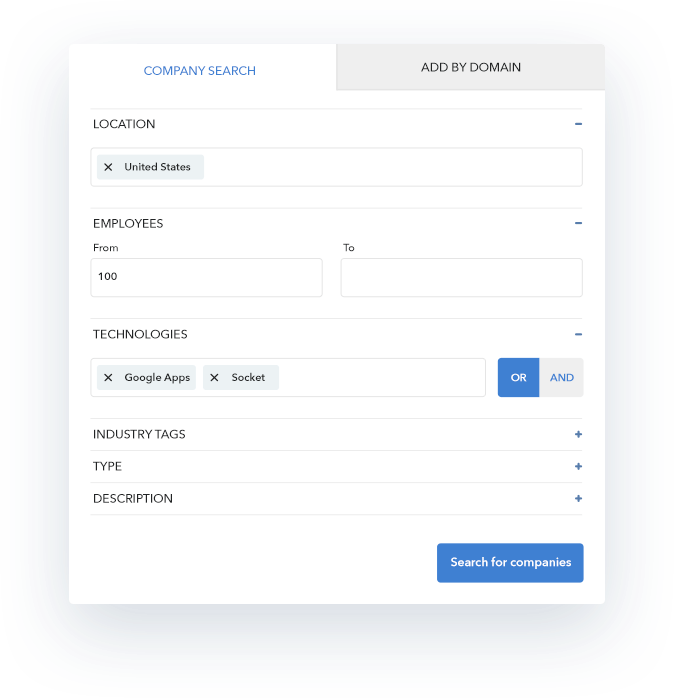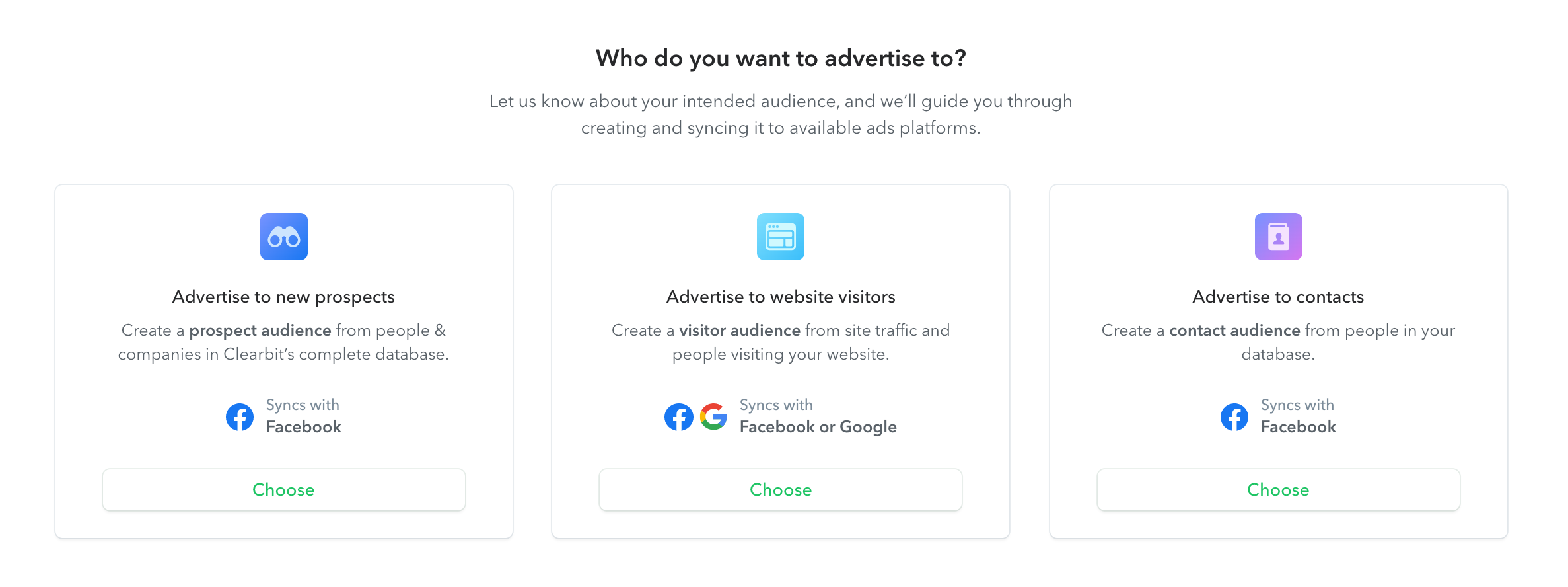Building an enterprise growth engine when you're product-led
Your product is built to sell itself, and you've spent countless hours experimenting and optimizing for organic adoption of your product. Yet every successful business pursuing product-led growth eventually needs to establish an enterprise sales motion.
As a growth marketer, this can be a tough transition. What once was a simple dichotomy between free users and customers becomes complicated with the introduction of new teams, new metrics (account engagement, MQA, influenced pipeline), and new workflows.
You now have to blend two distinctly different motions: a low touch, product-led path where the user matters most, and the high-touch, sales-led path where the account reigns supreme.
Here's an overview of how you can use Clearbit to build a sustainable enterprise growth engine without sacrificing your existing self-serve efficiency.
Identify signals from the noise
Now that you have two distinct tracks, it's more important than ever to be able to serve the most relevant experience to each. For example, you might want the CTA for your target accounts to talk with sales while encouraging self-serve visitors to sign up for your free product. The same goes for your upgrade path, where you might allow smaller teams to self-serve a monthly plan using a credit card, while funneling larger teams who would qualify for an enterprise plan to the sales team.
One of our customers, Livestorm was able to make simple changes to their homepage's headline, CTA, and navigation (via the personalization platform Mutiny) when detecting traffic from visitors at companies with a large enough employee count. In doing so, they were able to triple enterprise signups, increase their average deal size, and ensure that only high-quality leads were able to talk to sales.

That last point is important because every self-serve lead that gets through to sales is suboptimal for both parties. Introducing friction for a self-serve user annoys them when they want to play around with your product, while your sales team is frustrated by talking to someone who isn't ready to buy. The inverse also holds true!
Use Clearbit Reveal to instantly de-anonymize your web traffic so you can personalize your website experience for both self-serve and enterprise visitors.
But it's not enough for your enterprise growth engine just to identify enterprise versus self-serve visitors, it also needs to help prioritize which accounts are in-market and ready to buy your product.
Focus your sales reps' time on the highest-priority deals
A survey of time management amongst 720 sales reps revealed that two-thirds of their time gets spent on non revenue-generating activities — in other words, not selling. Increasing the quality of reps' time starts with providing better prioritization, so they know exactly which accounts to go after and spend more time connecting with the right stakeholders, instead of researching every lead in the queue.
Luckily as a company with product-led growth, you have access to more data than most companies could imagine. You've probably already defined your "aha" moment and developed sophisticated engagement metrics to identify user segments that are ready to upgrade.
However, as you go upmarket, firmographic indicators start to matter as much as product engagement. In fact, some of your enterprise buyers might not even sign up for your free version, so you need to incorporate other intent indicators to surface these accounts as well.
The new game plan: identify and prioritize high-fit accounts showing high-intent and find the right people to talk to at those accounts to connect when interest is at its peak.
Using Clearbit: first, you can build highly-targeted segments of your best fit accounts, based on any combination of your first-party data and Clearbit data, including:
- Data on your ideal customer profile: Both firmographic (company) data like employee count, industry, and location and job data like role and seniority
- Intent data from your website like page views and which specific pages they visited (aggregated at the account level)
- CRM data from Salesforce
- Custom traits using our Javascript snippet or Segment integration

Then, use our Alerts functionality to send notifications to your sales team via Slack, email, or directly in Salesforce whenever an account enters or exits one of these segments. Your sales team can then immediately take action on this intent by reaching out at just the right moment.
But who exactly should your team reach out to? In an ideal world, the power user of your product is also the buyer, but in enterprise sales that's not always the case! For example, there might be hundreds of users at the same company who signed up for a free Dropbox account, but it won't matter if sales can't engage the right IT director who owns the budget for collaboration tools.
That's where smarter prospecting comes in. The average enterprise deal has 7 stakeholders involved in the purchasing evaluation. Clearbit Prospector allows your sales team to find accurate contact information on decision makers so you can penetrate these buying committees effectively.

Now imagine the same Dropbox scenario with access to all of the data Clearbit has. You build a segment that contains any accounts in your ideal customer profile that reach a certain usage threshold. Anytime a new company enters that segment, your sales team get a real-time alert. Using our native Salesforce Enrichment integration, they quickly check the titles and seniority of those power users, and if necessary, use Prospector to find contact information on the decision maker.
Scale B2B social advertising
Feeding sales with high-value opportunities will help to build pipeline, but that won't be enough to hit your number. Clearbit Advertising can get you there by generating and converting demand with better B2B targeting on ads.
The beauty of an efficient product-led growth business is that your acquisition costs are reduced by the built-in virality of your product. If one signup on average invites two new users to your app for free, you can spread the cost effectively to make the economics work in your favor.
Traditionally, marketing to enterprises offers no such advantages, and you have to sacrifice somewhere. On LinkedIn or Adwords, that means having to pay up for access to better firmographic targeting or high-intent search terms.
On Facebook, the median cost per click is 10x less than LinkedIn, but you don't have the native targeting you need to reach business buyers. Uploading your own CSV's doesn't work because the match rate is dismally low and requires constant data maintenance.
You might have also checked out some account-based marketing vendors that offer their own display network, but does anyone even click on those ads anymore (on purpose that is)?
To address these pains, Clearbit Advertising delivers LinkedIn-level targeting on Facebook's platform. Our customers have seen tremendous success thus far. Here are a few of our favorite stories:
- Frame.io was able to improve match rates by more than 3x - from 15% to almost 50% when switching from uploading CSV's to dynamically syncing Clearbit segments directly to Facebook
- Zenefits drove a 33% larger median company size and a 20% increase in the conversion rate from prospect to qualified lead on Facebook.
- Compared to $30 a signup on LinkedIn, Lattice spent roughly $12 a signup from Facebook, with similar, if not more precise, targeting capabilities.
- Airbase saw cost per click on campaigns targeting net new prospects using Clearbit Advertising has been about half that of LinkedIn — $4 to 8 on Facebook versus LinkedIn's $8-16.
Leveraging the exact same segment builder mentioned above, you can create any number of hyper-targeted segments and sync them directly to Facebook. With all of your data plus Clearbit's 3rd party data you'll be able to run campaigns to all of the audiences you care about (and create exclusion audiences for the ones you don't).

Charlie Liang, Head of Demand Generation at Lattice explains it best:
Very few B2B companies actually execute successful Facebook ad campaigns. They'll tell you it drives a lot of leads, but what they don't tell you is that it can drive a lot of garbage leads, and it pisses off your SDR team. Clearbit solves this problem for B2B marketers that has been talked about for a really long time. It was like a breath of fresh air.
Build your enterprise machine around our growth engine
While the introduction of an enterprise sales motion can be tough to manage, there's no reason for you to sacrifice the growth principles that got you there in the first place: being quantitative, experiment-driven, and laser-focused on delivering value to the user. By building your machine around Clearbit's growth engine, you'll be able to unlock new channels and tactics to write your own enterprise playbook.

